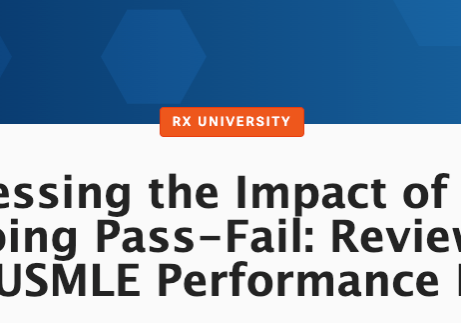[youtube https://www.youtube.com/watch?v=ZavDVF9qZtc&w=560&h=315]
As a part of Medscape’s Best Practices series, First Aid senior editor, Dr. Tao Le, sat down with Neil Bhavsar to discuss recommendations on how to use USMLE-Rx when preparing for the USMLE Step 1.
On when to begin using USMLE-Rx
“USMLE-Rx works best if you use it longitudinally with your course work. I would suggest that you use it starting about a year, maybe a year and a half, before your actual boards. People would say, ‘Wow, that’s a long time'” If you think about it, time flies when you really are engrossed in it. All of a sudden, you’ll realize, ‘Gosh, I feel like I don’t have enough time.’ If you actually invest [the time] and use it along with your coursework all along the way, then you’re going to be that much more prepared for the boards.”
How to use USMLE-Rx alongside First Aid
“Students, when they go between USMLE-Rx, the [Qmax] question bank, and First Aid, will annotate. As you know, in USMLE-Rx, we provide the First Aid facts…so you can see where they’re at. You can either annotate there, especially if you have the Rx360 package, which allows you to annotate First Aid, or you can go straight to the book and then annotate there as well.
“Bottom line: Use First Aid with your coursework throughout the year, especially as soon as your curriculum goes into organ systems. Most curricula [involving] organ systems have integration now—pathology, pharmacology, and so forth. Use it along the way. Same thing with the Flash Facts—do that along the way. Flash Facts is a fantastically active way to learn First Aid, because if you get the answer to each digital flash card, you’ll get a direct section out of First Aid that’s [linked] to that flashcard. You’re getting multiple passes through First Aid just by doing the digital flashcards. Do that just like you were doing Anki; try to do anywhere between—if you’re starting your second year—50 to 100 flashcards a day. It [will only] take between 5 and 10 minutes—it’s really fast.”
On the Importance of Patient-Centered Explanations in a Qbank
“The explanations we use in USMLE-Rx are very unique. Obviously, there are other question banks out there. The one thing that we do, I think really well, and just about better than anybody else, is that the explanations are actually patient-centered and case-centered. Think about it: Next year, when you’re on internal medicine, or whatever, that person in front of you is not a multiple-choice question. That person is a person. You are going to be trying to solve it through their eyes, what information they’re giving you. We try to position all of the information through a little bit of the eye of the patient….In this, we break it down that way and then we logically break down the multiple steps you have to go through to solve the question.
“Once you go through these explanations, over time you’ll realize that it’s based on the stem—the stem is the case—and then based on the lead-in, which is the actual question. We’ll give you the tools to figure out whether that’s a one-step question, a two-step question, or a three-step question, and then the sequence that you have to solve in each of the steps to be able to get to that answer. [You will] actually be able to break down the case through the eyes of the patient which, by the way, is what you want to do when you’re a good doctor, whereas a lot of others tend to be disease-centric.”
To read the full transcript, head here.




